The Amazon River stretches across South America and is truly majestic. The US Geological Survey says it’s about 4,000 miles long. Yet, new findings hint that the Mantaro River might add another 47 to 57 miles. This could change how we see this area rich in biodiversity. The rainforest ecosystem envelops the Amazon, and its true source is still debated, inspiring scientific exploration.
This river network supports numerous freshwater species and boosts human exploration and tourism. The Marañón River was once considered the Amazon’s source in the 1700s. Today, our understanding of its source is changing. The Mantaro River’s path is interrupted by a dam, raising questions about what defines the start of this mighty river.
The Amazon is a sanctuary for wildlife and a focus for conservation efforts. Its complex path intrigues people worldwide, who wonder about its true length and the diverse life along its banks. The river’s story is as complex and varied as the Amazon itself.
Key Takeaways
- New research into the Mantaro River may redefine its length as it competes for the title of the longest river on the planet.
- Based on water volume, the Marañón River’s historical significance underscores the evolving nature of identifying a river’s source.
- The controversy around continuous flow and the Mantaro’s seasonal dryness brings to light the complexities of hydrological mapping.
- Reliance on the proposed farthest source definition, due to the Mantaro River’s pathway, could elevate the Amazon’s status.
- Understanding the Amazon’s origins is crucial for biodiversity conservation, tourism, and preserving South American ecology.
The Enigmatic Origins of the Amazon River
The Amazon River could be the longest river in the world. Scientists and explorers are fascinated by its origins. Starting near the Peruvian Andes, it travels across South America to the Atlantic Ocean, telling the story of the continent itself.
The Geographical Source: Andes to the Atlantic
The Amazon starts in the Andes, the beginning of its impact on the continent. It flows through a vast river basin across many countries, supporting diverse ecosystems. It’s known as “The Heart of South America,” connecting the Peruvian highlands to the Brazilian lowlands.
Amazon River Basin: The Heart of South America
The Amazon River Basin shows the river’s complexity and vitality. It covers about 2.7 million square miles. Home to an incredible range of tributaries, its size and diversity influence the entire continent’s landscape and weather.
Hydrology of the Amazon: Flowing Systems and Tributaries
The Amazon is where water’s complex movements are on display. It creates a vast network starting from the Ucayali-Apurímac rivers and is supported by many tributaries. This network changes climates, waters, and lands, supporting countless lives in Peru and Brazil.
| Drought Impact | Archaeological Discovery | Estimated Undiscovered Sites | Rainforest Clearing |
|---|---|---|---|
| The current severe drought exacerbated by El Niño | Ancient geoglyphs resurfaced along Negro River | 10,272 to 23,648 earthworks | 17% of the Amazon rainforest cleared |
| Ancient engravings visible due to low water levels | 24 Pre-Columbian earthworks found recently | More than 10,000 hidden sites | Concerns over a tipping point for rainfall sustainability |
| Carvings suggest civilizations over a millennium old | Indigenous societies might have numbered 5 million | Land Alterations Affecting Climate Change Adaptation | Historical human Impact Altering Rainforest Composition |
The Cultural Tapestry: Indigenous Tribes of the Amazon
The indigenous tribes of the Amazon, like the Yanomami, guard the area’s cultural richness. They are key to its biodiversity. Facing modern challenges and environmental risks, they remain vital. They help conserve the Amazon rainforest and sustain river life. Let’s explore the Yanomami’s struggles and how indigenous wisdom helps the Amazon’s nature.
Yanomami Tribe and Their Challenges
The Yanomami have kept their culture alive in the Amazon for centuries. Yet, they face severe threats, like mercury pollution from gold mining. This endangers their health and harms the river’s ecosystem, which many creatures rely on.
Some indigenous groups are on the brink of vanishing. For instance, only four Akuntsu tribe members are left. The ‘Man of the Hole,’ alone in his fight, symbolizes the existential crisis of tribes like the Mashco Piro. These tribes, with deep-rooted knowledge, are crucial for the rainforest’s future.
Indigenous Influence on Amazon’s Biodiversity
The rubber boom in the 1870s shows a hard history between Amazon tribes and outsiders. Rubber barons exploited native people, marking a dark time. Yet, this didn’t erase the tribes’ impact on the Amazon’s nature. Their ancient practices taught them how to care for and protect their environment, which is essential for Amazon’s protection today.
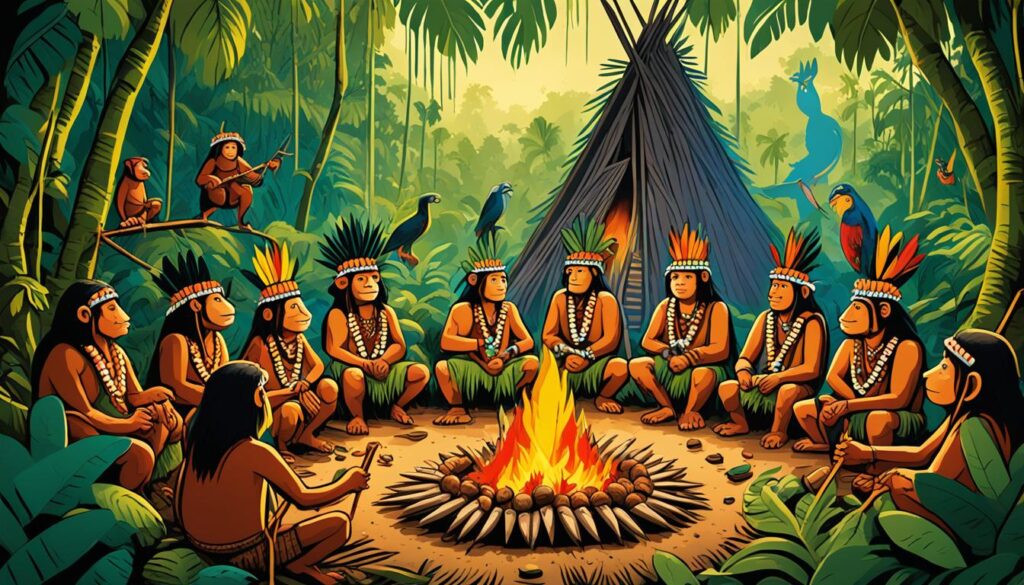
| Tribes | Current Status | Challenges |
|---|---|---|
| Akuntsu | Four remaining members | Threat of extinction |
| Man of the Hole | Last of tribe | Solitude, deforestation |
| Mashco Piro | Isolated and endangered | Lack of protection and rights |
| Yanomami | Facing mercury exposure | Illegal mining, health issues |
In conclusion, Amazon’s indigenous people lead us to appreciate nature and ancient knowledge. They guide global conservation efforts. It’s crucial to safeguard the biodiversity and the cultural history that define the Amazon’s spirit.
Unveiling the Biodiversity Hotspot: The Amazon Rainforest
The Amazon rainforest is a huge pillar of life on Earth. It is home to an amazing biodiversity. Spanning 1.4 billion acres, it’s more than a vast wildlife habitat. It’s an ecological gem that transpires huge amounts of water into the air every day. This helps maintain the health of the planet’s water cycle. It also holds a big part of Earth’s biological diversity, making it key for conservation.
To match the Amazon rainforest’s big role, conservation efforts are growing. Projects like National Geographic’s Perpetual Planet Amazon Expedition lead the charge. They fund important studies exploring this area’s deep richness and weaknesses.
From the high Andean mountains to the dense Amazon river networks, 20% of the world’s river water flows through this forest. It’s a hub of global biodiversity but is under serious threats.
The Lovejoy experiment shed light on how breaking up habitats can harm. It showed how fast ecosystem decay can lead to less species diversity.
Brazilian laws now require landowners to keep half their forest land to fight biodiversity loss. This rule is just as important now as when it was made. It shows how critical conservation efforts are worldwide.
| Amazon Rainforest Statistics | Significance |
|---|---|
| 1.4 billion acres of cover | The world’s largest rainforest, unparalleled in scale |
| 20% of the planet’s river water | Crucial to global water and climate cycles |
| Seven trillion gallons of water daily | Significant ecological impact through transpiration |
| Perpetual Planet Amazon Expedition | Supports pivotal biodiversity research in the region |
- Ecosystem studies from the 1970s show how isolated forest islands quickly lose biodiversity.
- Photo surveys stress looking deeper—revealing the aquatic life to understand this wonder completely.
Lovejoy’s work in the Amazon showed that bigger conservation areas are better. It taught us how patch size affects species loss. These lessons help guide smart conservation efforts and ensure we can protect the rainforest for future generations. As Earth’s caretakers, we must take care of this vital biodiversity hotspot.
The Diverse Wildlife of the Amazon River
The Amazon River is full of wildlife, making it one of the richest places for animals on Earth. It is home to many freshwater species, which include some huge and intriguing ones. These creatures are crucial for keeping the ecosystem balanced and are a big part of the Amazon’s culture.
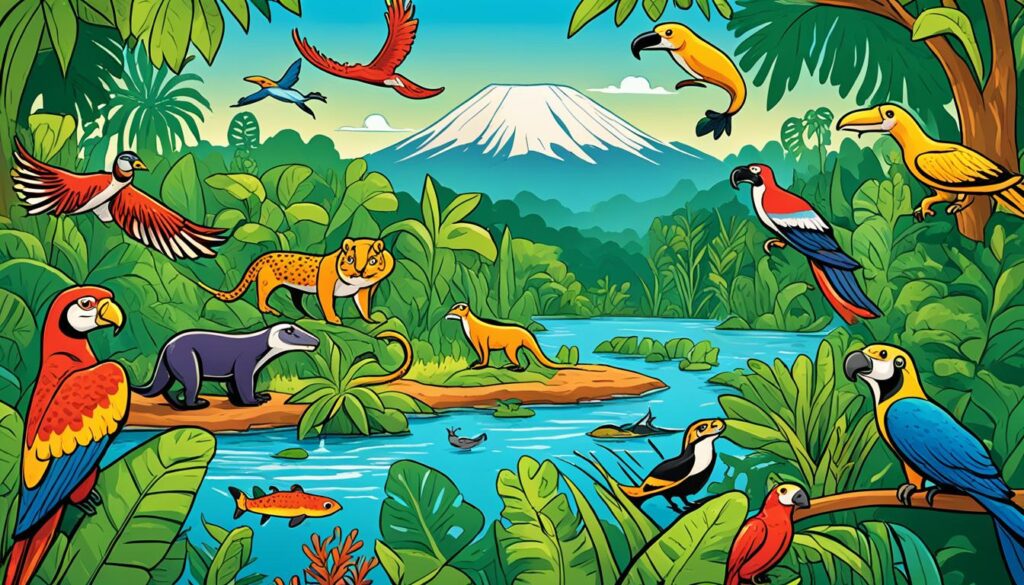
Freshwater Giants: Pirarucu and Giant Catfish
The Pirarucu is known as a giant in freshwater fish, one of the world’s biggest. The giant catfish also plays a key role, especially for local fishermen. Both of these fish are among the 2,500 species in the Amazon. They help make the river a place of amazing biodiversity.
Predators Beneath the Surface: Anacondas and Caimans
Anacondas thrive in the Amazon’s wetlands, using their power to hunt. They can even take down large caimans. This shows the wild and complex nature of life in the Amazon.
River Dwellers: Pink Dolphins and Manatees
Pink dolphins are magical creatures that enchant anyone who sees them. They are smart and have a unique pink color. They live peacefully with manatees, another interesting river animal. But, manatees are in danger, which shows how fragile this ecosystem is.
Threats like less rain and more tree cutting are harming the Amazon, as are issues like pollution and overfishing. This is why projects like AmazonFish are so important. They help us understand and protect the diverse wildlife in the Amazon.
Exploring the Largest River: Amazon River Facts
The Amazon River is truly amazing, holding records that wow us all. It’s often discussed as the longest river in South America and maybe the whole world. Its vast network stretches across the continent. But the Amazon is more than just long. It’s the largest river in terms of how much water it carries, showing its true size.
Comparing Length: Is the Amazon Longer than the Nile?
People can’t agree if the Amazon or the Nile is longer. Recent studies suggest the Amazon might be longer than the Nile. But, no matter the debate, the Amazon is significant. It flows through South America, linking many ecosystems and cultures.
Record-Breaking Volume: The World’s Largest River by Discharge
According to a report, the Amazon River’s flow is the biggest in the world. It releases a huge amount of water into the ocean, more than any other river. This makes the sea less salty, far from the river’s mouth, and affects our planet’s system.
Regarding carbon, Amazon’s effect on the Atlantic Ocean is huge. A study in 2007 showed it adds about 30 million tons of carbon to the air each year. Yet, the polar seas absorb more carbon, a key fact for climate scientists. They get a lot of funding to study these big issues.
The Amazon River greatly impacts our world, both nearby and far away. It’s not just the longest river in South America or the largest river by volume. It plays a big role in how the world’s rivers affect our environment and climate.
The Untold History of Amazon River Exploration
The story of the Amazon River starts with its deep history of exploration. The journey began with the Spanish Francisco de Orellana in 1542. He was the first European to sail along its length. This event opened the door to meeting the indigenous tribes of the area. It began a lasting interest in one of the most mysterious rivers in the world – the Amazon River.
First Encounters: Francisco de Orellana’s Discovery
Orellana’s first trip on the Amazon stands out for its bravery and impact. He didn’t just find a river; he found a whole ecosystem, alive with indigenous culture. His journey faced many dangers, including a complex network of streams and aggressive locals. This changed how Europeans saw the world’s geography.
Historias del Rio Amazonas: The Local Narratives
European stories of exploration mix with the river’s native tales. Legends as colorful as the river show a life in harmony with nature. These stories help us understand and respect the Amazon. They are key to knowing the full history of this huge area.
| Expedition | Year | Explorer | Impact |
|---|---|---|---|
| Orellana’s Odyssey | 1542 | Francisco de Orellana | First European traversal, interaction with indigenous tribes |
| Roosevelt-Rondon Expedition | 1914-1926 | Theodore Roosevelt and Cândido Rondon | Mapped the River of Doubt, highlighted the region’s geography |
| Modern Day Research | 1200-1500 A.D. & Present | Archaeologists and Scientists | Unearthed ancient settlements, revised population estimates |
Today, explorers and scientists keep finding Amazon secrets, learning more than ever. They use lidar to see through the thick forest and conduct detailed archaeological studies. We are discovering a more complex and rich history of the Amazon River and its people.
Conservation Efforts: Protecting the Amazon’s Future
The Brazilian Amazon is rich in life but faces big challenges. Deforestation is a major threat to its unique creatures and the worldwide climate. Fortunately, projects focusing on saving the rainforest and promoting ecotourism offer hope. These initiatives support using the land wisely. They also blend saving nature with helping communities and shaping policies. This helps keep the Amazon’s balance and ensures its wildlife and role in absorbing carbon remain secure.
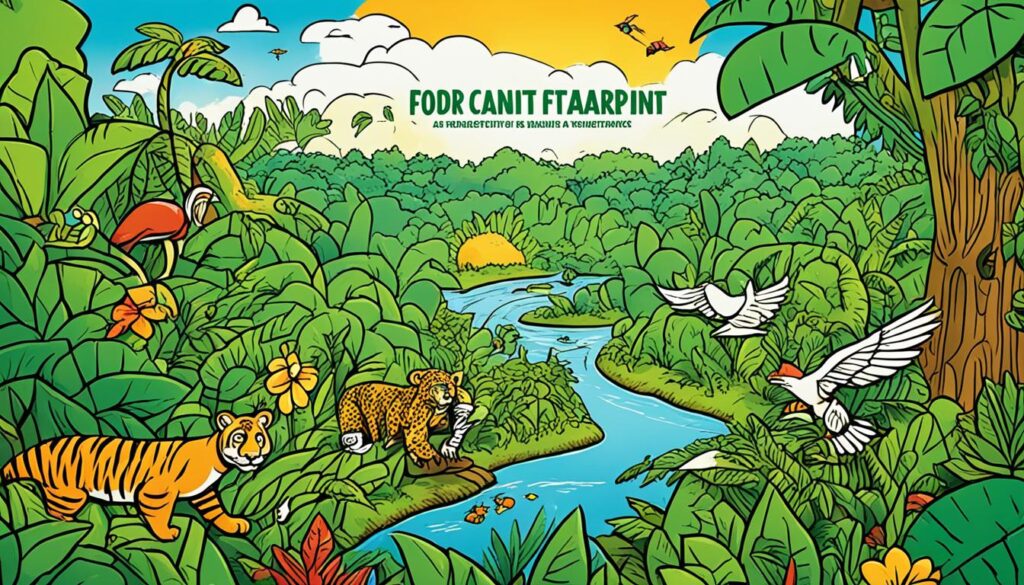
Deforestation in the Amazon means more than just losing trees. It’s about losing the wide variety of life on Earth. The Amazon is home to up to one-fourth of the world’s land species. When forests are cut down for fields, this hurts both the variety of life and water cycles. Nearly 70% of lands cleared become pastures, damaging the link between different forest areas.
Combating Deforestation and ‘Narco-deforestation’
Illegal logging and ‘narco-deforestation’, linked to drug trafficking, make the situation worse. But actions targeting these issues are making a difference. Brazil has seen lower deforestation rates since 2006, thanks to strong policies. Plus, governments and international efforts are working on eco-friendly product labels. The ASL program helps by linking protected natural areas with places people use for work. This boosts the fight against losing forests.
Rainforest Conservation Projects and Ecotourism
Ecotourism is key in raising awareness about saving the Amazon. It highlights the importance of guarding the area for the future while offering other ways to make money that don’t harm the environment. Indigenous people, guarding about a quarter of the Amazon, are crucial. They use age-old wisdom to protect the diverse life there. Projects focusing on reforesting and sustainable management help the Amazon’s “flying rivers.” These air streams carrying moisture are important for food supplies from Brazil to Argentina.
The Amazon’s forests hold about 150 billion metric tons of carbon, playing a huge role in controlling climate change. But, if deforestation doesn’t slow down, more than half of the Amazon might become a savanna. There’s hope that money from industries like aviation and shipping could support saving the forest. This could lead to a stronger, more diverse, and stable Amazon regarding climate.
Navigating the Amazon: River Cruises and Tourism
Going on an Amazon River cruise means stepping into the world of ecotourism. You will see the Amazon’s beauty up close. Manaus is the main gateway to this great river. It’s the perfect starting point for an adventure that combines fun and caring for the environment.
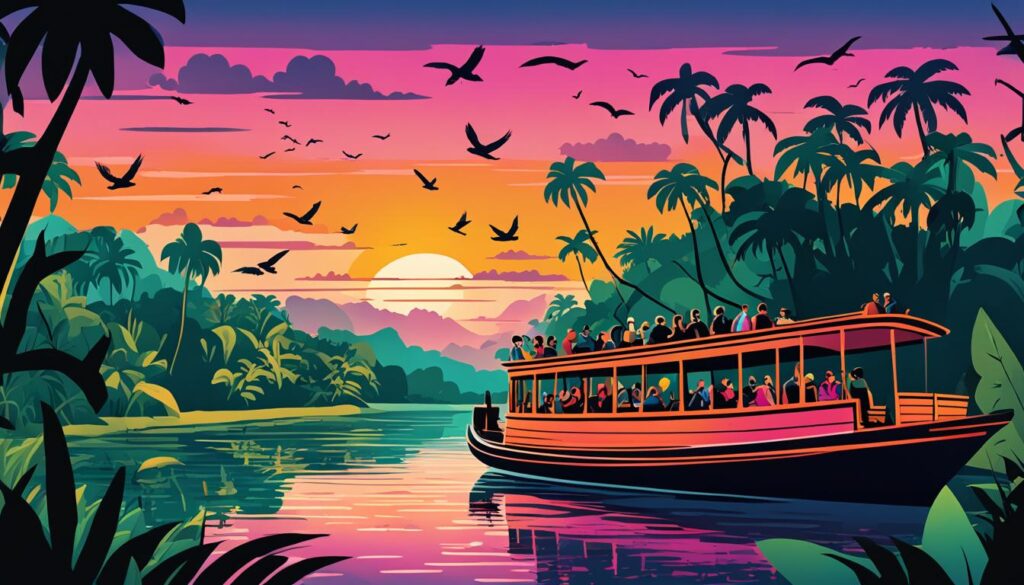
Traveling down the Amazon, you notice the focus on sustainable practices. These efforts help keep the region healthy. They show the importance of traveling responsibly.
Manaus: The Gateway to the Amazon
Manaus is not just the capital of Amazonas but also the beginning of many journeys. It’s a place where city life meets the wild. Visitors get a glimpse of Amazonian culture before setting off on their cruise. The city links the wild Amazon with those eager to explore it.
Ecotourism and Sustainable Practices
Following ecotourism rules, Amazon River cruises work to protect the environment. These actions help preserve the Amazon and support the people who live there.
| Expedition Statistic | Detail |
|---|---|
| Total Duration | 9 days |
| Maximum Guests | 28 |
| Cost per Person | $8495 (+air) |
| Reserve Size | 5 million acres |
| Naturalist Guides per Voyage | 3 |
| Average Guide Experience | At least 10 years |
| Nat Hab Carbon-Neutral since | 2007 |
| Nat Hab Expedition Leaders | 2 |
Natural Habitat Adventures showed its dedication to conservation by turning carbon-neutral in 2007. This move strengthens the mission of an Amazon River cruise. Every traveler plays a role in shaping the future of sustainable tourism.
The Hydrological Marvel: Amazon River and Climate Interaction
The Amazon River acts as a vital climate regulator worldwide. It supports numerous freshwater species, making it a crucial part of climate balance.
The river not only supports countless species but also shapes weather far away. The fresh water it sends to the Atlantic changes ocean conditions, affecting weather across the globe. So, the Amazon keeps the climate balance on earth.
“The Amazon, with its boundless vitality, represents an ecological cornerstone, vital for the balance and biodiversity it nurtures within and beyond its waters.”
Let us delve into some compelling statistics showing Amazon’s key role within the broader context of global eco-systems and climate interaction:
| Attribute | Amazon River & Region | Impact on Climate |
|---|---|---|
| Freshwater Output | Imposing volume released into the Atlantic | Modifies oceanic salinity, influences global water circulation |
| Climate Dynamics | Intricate water cycle, major regional precipitation | Essential to regional and global climate equilibrium |
| Biodiversity | Myriad freshwater species | Sustains a diverse ecosystem, influencing local and global biodiversity |
| Climate Regulation | Lush forests, extensive carbon sinks | Aids in carbon sequestration mitigates greenhouse gas effects |
The Amazon’s system shows Earth’s climate complexity. Exploring it reveals the link between our world and vital ecosystems. It’s a reminder of our planet’s beauty.
To sum up, the Amazon does more than support species. It’s key to controlling the climate worldwide. It shows how everything is connected, underlining the need to protect it from harm.
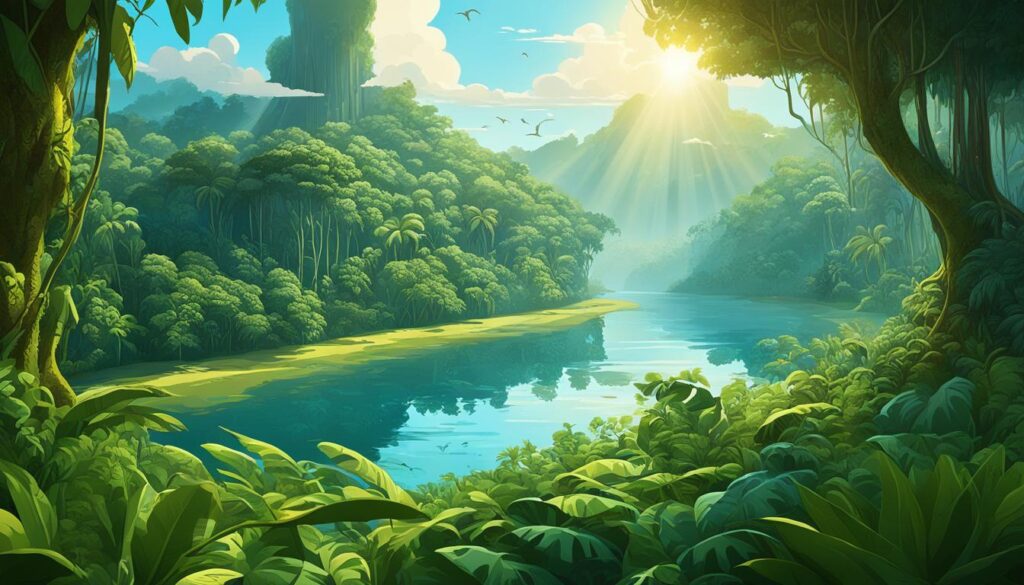
Mapping the Mighty Amazon
The quest to map the Amazon River has transformed with the digital age. Mapping has gone from basic drawings to precise details thanks to GPS and satellite imagery. These tools have changed our view of the river’s long, winding path. They not only support academic studies but also help protect the environment.
GPS and the Digital Age: Charting the Uncharted
The true source of the Amazon is now confirmed as the Mantaro River, thanks to GPS technology. This tech provides exact locations and updates the Amazon River map with precision. GPS is essential for researchers and explorers covering the Amazon’s vast 4,000-mile journey. It helps collect data in tough, often unreachable areas. This shows the value of GPS in learning about complex river systems like the Amazon.
Traditional Maps Vs. Satellite Imagery
The length of the Amazon was once debated with old maps and explorations. Now, we look at it from space. Satellite pictures show the river’s size changes with the seasons, expanding up to 30 miles wide when it rains. This view is better than old maps. It shows the Amazon and its tributaries in real-time, revealing the dense forest and the diverse life it supports.
The combination of GPS and satellite pictures marks our move into the digital era. It gives us a map of the Amazon River that’s as vibrant and detailed as the river itself.
Comparing Ecosystems: Amazon River Versus Other Global Rivers
The Amazon River stands out globally because of its biodiversity hotspot status. Its size and ecological role are unmatched, making it a central biodiversity point. The numbers show its vast wildlife and significant impact.
The Amazon Basin covers over 6 million km2 and produces 20% of the world’s freshwater. This places it at the top for freshwater richness worldwide. It includes about 15% of all known freshwater fish.
| Parameter | Amazon Basin | Other Global Rivers |
|---|---|---|
| Area | 6,000,000 km2 | Varies significantly |
| Freshwater Species | 2,406 native fish species | Limited biodiversity compared to the Amazon |
| Data Sources | 590 sources, including articles, databases, collections | Less comprehensive datasets |
| Historical Data Range | 1834–2019 | Varies, often not as extensive |
| Threats | Deforestation, infrastructure, pollution, overfishing | Different per region, often less severe |
The AmazonFish project shows the Amazon has 2,406 distinct fish species. It’s still being explored, with new finds often. This hints at even more undiscovered wildlife.
Other global rivers have key roles, but none match the complexity of the Amazon’s wildlife habitat. The Amazon Fish database records nearly two centuries, showing long-standing biodiversity. It helps greatly with ecological and conservation research.
“As we face the urgent need to preserve our planet’s biodiversity, the Amazon serves as a living laboratory from which we can learn and implement strategies for conservation. The wealth of data available from the Amazon Fish database is unparalleled, offering us detailed insights into species-level distributions and population trends.”
Recent environmental shifts warn of the ecosystem’s fragility. Low water levels at Manaus and severe drought indicate climate change threats. We must step up our monitoring and protection to keep this ecosystem safe. This will ensure that Amazon continues to support a vast range of life.
Captivating Amazon Legends and Folklore
The Amazon’s cultural richness comes from its unique folklore and legends. These tales echo through the rainforest, telling of the deep bond between people and nature. They are not just stories but the essence of Amazonian life, connecting past and present.
William Moulton Marston created Wonder Woman in 1943, inspired by Amazonian myths. This comic book hero stands for female strength, much like the legendary Amazons. Wonder Woman shows the power and independence rooted in the region’s stories.
In 1861, Johann Jakob Bachofen suggested the Amazons were real, leading a matriarchal society. This idea sparked interest and debates about the historical truth of warrior women.
Greek myths also celebrate Amazons as fierce warriors. They have captured imaginations since Homer’s Iliad, with Greek art from the sixth century B.C. depicting their battles. This art shows Amazons fighting heroically, highlighting their strength and courage.
Historian Herodotus, in the fifth century B.C., wrote about the Amazons. He gave them a capital at Themiscyra and described their way of life. This added depth to the Amazonian folklore.
In the 1990s, a U.S.-Russian team found graves of warrior women, proving some legends true. These findings link back to the Amazons, bridging myth and history.
The Amazon’s stories reflect its unique Amazonian heritage. They show how indigenous people understand their environment. Through tales, we see their respect for nature and their storytelling tradition.
The Annual Flood Phenomenon: Amazon River’s Rising and Falling Tides
The annual flood of the Amazon River showcases nature’s impressive water systems. It’s a balance that supports the rainforest ecosystem. The forest, spread across 7 million km², benefits from rising and falling tides. These tides help move nutrients and enrich the soil, which is crucial for the forest’s health. Learn more about this.
The Amazon has seen many extreme weather events, from droughts to floods. These events highlight the Amazon River basin’s strength. They help move important resources around, supporting a vast amount of life. This is why the Amazon has the world’s largest river flow, making up 20% of the global river discharge.
The Amazon River’s role goes beyond just its flow rate. It adds more freshwater than the Congo River, five times more. This shows its huge impact on the world’s water resources.
The weather in the Amazon Basin generally stays the same, with about 2190 mm of rain a year and about 1100 mm of runoff yearly. But it’s the combination of evaporation (about 1250 mm a year) that creates the flood cycle. This cycle is complex but vital.
| Statistic | Value |
|---|---|
| Amazon Basin Area | 7 million km² |
| Average Precipitation | 2190 mm/yr |
| Runoff | 1100 mm/yr |
| Average River Discharge | 209,000 m³/s |
| Evapotranspiration Estimates | 1250 mm/yr |
The annual flood cycle shows how the Amazon River shapes its ecosystem. It has a big effect on the world’s water cycle.
Effects of Climate Change on the Amazon River Basin
The Amazon River basin is rich in life and vital for our climate and water cycles. Yet, it faces a massive challenge: climate change. This crisis is pushing us to act fast to save the rainforest. The world is nearing a dangerous temperature increase of 1.5 degrees Celsius, which has led to severe droughts in the basin and highlighted the need to fight deforestation.
This warming trend greatly increases droughts in the Amazon, making the rainforest 30 times more likely to suffer from drought. This has caused the death of over 178 pink and grey river dolphins, and thousands of fish have also died due to low water and oxygen levels.
- Highest global temperatures as a primary catalyst for Amazon’s historic drought
- Nine countries are suffering drought repercussions across the Amazon region
- Unprecedented scope of droughts over the past two decades
Precipitation in Brazil’s north has hit a 40-year low, disrupting natural cycles. The intensity of El Niño events is likely to rise. The World Meteorological Organization warns of a ‘super’ El Niño. This could worsen the climate stresses in the Amazon.
Efforts to combat deforestation are showing signs of success in the Brazilian Amazon. Yet, with 20% of the rainforest gone and 40% degraded, the risk of fire and drought grows.
In the Amazon River basin, water levels are dropping significantly. The Negro River’s depth is the shallowest in over a century. Many smaller tributaries are drying up. The basin’s capacity to store carbon and freshwater is at risk due to the heat.
Thus, saving the rainforest is crucial for the climate. The Amazon River basin needs action now to stay healthy. It’s a key part of our global environment.
- Dire predictions of worsening drought conditions if global warming continues
- Increased drought frequency due to climate change
- The recent recovery of river levels but with less rainfall expected
The climate’s effect on the Amazon is changing fast. Saving the Amazon River basin is essential. It’s not just about the ecosystem but keeping our global climate balanced.
Final Thoughts
The story of the Amazon River is like a painting. It shows the importance of nature, powerful waterways, and rich cultural history. This river stretches over 4,000 miles through South America, making it the world’s second-longest river. It’s only shorter than the Nile River in Africa. Its area is vast, almost double that of the Congo River’s basin.
This region is crucial for the environment and is home to over a million species in the Amazon Rainforest. This area is vital for the planet’s various life forms. The Amazon’s story is also made more interesting by early explorers like Francisco de Orellana. There are also many indigenous cultures that have lived by this river for thousands of years. Their knowledge and way of life help us understand and protect this area’s natural resources.
Along its path, the Amazon’s water flow is much larger than that of the Congo and Mississippi Rivers. This shows its key role in our world’s natural systems. However, this beautiful region faces dangers from human actions, like the cutting down forests, especially near the Andes mountains. But there’s hope. People worldwide are working to protect the Amazon, such as climate change, from harm.
Looking at the Amazon, we see it’s more than just a river. It’s a place full of life, important for local cultures, and essential for the environment globally. Protecting it is not just about saving a river; it’s about keeping our planet’s delicate natural balance safe. This is a task we all must take part in.
FAQ
What is the Amazon River known for?
Where does the Amazon River originate, and where does it flow?
How does the Amazon River affect the biodiversity of the surrounding ecosystem?
What are some main threats to the Amazon River and its ecosystems?
Can tourists visit the Amazon River?
What conservation efforts are in place for the Amazon River?
How long is the Amazon River?
What types of wildlife can be found in the Amazon River?
What cultural significance does the Amazon River hold?
How does the Amazon River’s discharge compare to other rivers?
Why are the Amazon River and rainforest crucial for the global climate?
What is ‘narco-deforestation,’ and how does it impact the Amazon?
Are there initiatives to map the Amazon more precisely?
How is technology being used to aid the conservation of the Amazon?
What role do indigenous tribes play in the conservation of the Amazon?
How often does the Amazon River experience flooding?
What can individuals do to help protect the Amazon River?
Source Links
- https://www.nationalgeographic.com/adventure/article/140213-amazon-river-length-source-maps-science
- https://news.artnet.com/art-world/brazilian-amazon-carvings-drought-2384763
- https://www.newscientist.com/article/2396260-the-amazon-may-contain-thousands-of-undiscovered-ancient-structures/
- https://www.scielo.br/j/ni/a/Y8BqkSjr3TVDjQnHhdWMDzx/?lang=en
- https://www.newyorker.com/magazine/2016/08/08/an-isolated-tribe-emerges-from-the-rain-forest
- https://www.nationalgeographic.com/environment/article/perpetual-planet-this-visionary-inspired-amazon-conservation-and-a-new-nat-geo-expedition
- https://www.britannica.com/place/Amazon-River/Animal-life
- https://en.wikipedia.org/wiki/Fauna_of_the_Amazon_rainforest
- https://www.nature.com/articles/s41597-020-0436-4
- https://www.nsf.gov/news/news_summ.jsp?cntn_id=111904
- https://www.history.com/news/the-amazonian-expedition-that-nearly-killed-theodore-roosevelt
- https://www.pbs.org/wnet/secrets/hidden-amazon-preview-kqftyv/6342/
- https://www.nationalgeographic.com/history/article/amazon-jungle-ancient-population-satellite-computer-model
- https://www.worldbank.org/en/news/feature/2019/05/22/why-the-amazons-biodiversity-is-critical-for-the-globe
- https://www.washingtonpost.com/opinions/interactive/2023/amazon-rainforest-how-to-protect/
- https://www.nathab.com/south-america/amazon-river-cruise/
- https://www.ncbi.nlm.nih.gov/pmc/articles/PMC7614759/
- https://www.nature.com/articles/s41467-020-17581-y
- https://www.livescience.com/57266-amazon-river.html
- https://www.washingtonpost.com/world/2023/06/12/amazon-nile-longest-river/
- https://www.cnn.com/2023/10/17/americas/amazon-river-lowest-levels-drought-climate-intl/index.html
- https://www.smithsonianmag.com/history/amazon-women-there-any-truth-behind-myth-180950188/
- https://www.theamazonwewant.org/wp-content/uploads/2021/08/SPA-Chapter-5-PC-the-physical-hydroclimate-system-of-the-amazon.pdf
- https://www.aljazeera.com/news/2024/1/25/global-warming-drove-record-amazon-rainforest-drought-study-finds
- https://www.scientificamerican.com/article/the-amazons-record-breaking-drought-is-about-more-than-climate-change/
- https://www.washingtonpost.com/climate-environment/2023/11/10/amazon-drought-deforestation/
- https://www.britannica.com/place/Amazon-River
